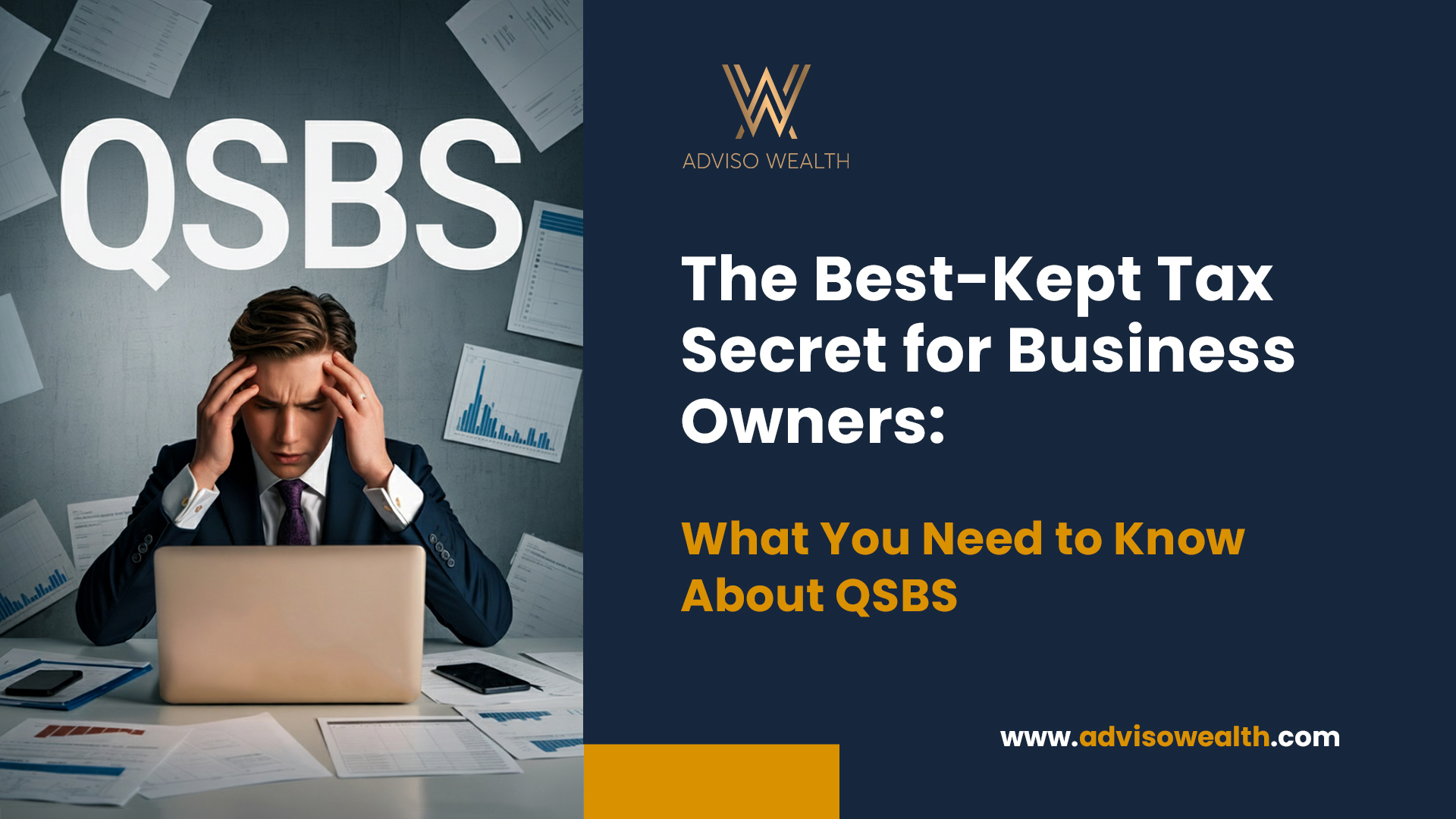The Best-Kept Tax Secret for Business Owners: What You Need to Know About Qualified Small Business Stock

You could sell your business and legally pay $0 in federal capital gains taxes on millions of dollars.
Sounds too good to be true?
It’s not. But it is complicated—and very few business owners understand how to actually take advantage of this powerful tax break.
The strategy?
Qualified Small Business Stock.
If you’re building a company—especially if you plan to sell one day—you need to know how QSBS works before the exit, not after. Because once the sale is done, you can’t go back and retroactively qualify.
Let’s unpack how it works, who qualifies, and why it could mean a seven-figure swing in your after-tax wealth.
The Hidden Problem: Exit Taxes Can Wipe Out Years of Work
You’ve spent years—maybe decades—building your business. You reinvested profits. You took risks. You worked weekends.
So when you sell, it should feel like a reward.
But for many business owners, the IRS takes a much bigger bite than they expected. And once that money is gone, it’s gone.
That’s where QSBS comes in.
If structured properly, you could exclude up to $10 million in capital gains—or more, in some cases—from federal income tax.
Yet most business owners miss it entirely because:
- They didn’t know their stock could qualify
- Their CPA brought it up too late
- The company structure didn’t meet the criteria
- They didn’t hold the stock long enough
- They sold before understanding the rules
This is one of the clearest examples of how early planning creates exponential wealth.
What Is QSBS?
QSBS stands for Qualified Small Business Stock, a provision under Section 1202 of the Internal Revenue Code.
Here’s the short version:
If you own stock in a qualifying C-corporation and meet certain criteria, you can exclude up to 100% of capital gains (up to $10 million or 10x your basis) when you sell.
The goal of this rule is to reward people who invest in and grow small businesses in America. It’s the government’s way of saying: “Thanks for creating jobs and taking risk.”
But it only applies in very specific circumstances.
Do You Qualify? Here’s the QSBS Checklist
To claim the QSBS gain exclusion, all of the following must be true:
- The Company Is a C-Corp
Sole proprietorships, partnerships, and LLCs don’t qualify. The business must be a C corporation when the stock is issued.
(Yes, that means an S-corp doesn’t qualify either. Sorry.)
- You Acquired Stock Directly
You must have received the shares directly from the company—either through purchase, services, or as founder stock. Buying shares on a secondary market or from someone else generally disqualifies them.
- You Held It for at Least 5 Years
The Qualified Small Business Stock exclusion only applies if you’ve held the stock for 5 years or more. There are some planning opportunities here with rollovers (more on that later).
- Gross Assets Were Under $50 Million
At the time the stock was issued, the company must have had less than $50 million in gross assets.
This test applies before and immediately after the issuance. So if your company raised a big round after your shares were issued, you’re still good.
- Active Business Requirement
At least 80% of the company’s assets must be used in an active business—not investment assets, real estate holdings, or passive income sources.
And certain industries are excluded altogether: financial services, law, accounting, hospitality, and a few others.
The Tax Savings: What’s at Stake?
Let’s look at a real-world example:
You start a tech company in 2020, issue yourself founder shares, and raise a seed round.
In 2029, you sell the company for $15 million. You meet all the QSBS criteria.
Your cost basis was $0.
Tax without QSBS: You owe 20% federal capital gains + 3.8% NIIT = $3.57 million
Tax with QSBS: $0 on the first $10 million (potentially even more with planning)
Result: You save $2.38 to $3.57 million in taxes
Now imagine this applies to multiple shareholders in a family. That’s when things get really interesting.
How an ESOP Actually Works
Here’s the typical flow of funds:
- External Loan: A bank lends money to the company.
- Internal Loan: The company then loans those funds to the ESOP.
- Purchase: The ESOP uses those funds to purchase shares from the selling owner.
- Repayment: As the company pays back the bank, shares are gradually released to employees.
Important points:
- Employees don’t fund the ESOP personally.
- The company receives tax deductions on its contributions (within limits).
- The owner receives liquidity, while employees benefit gradually as shares vest.
Bonus: Stack the QSBS Exemption with Gifting and Trusts
Qualified Small Business Stock isn’t limited to just one person. With smart planning, you can multiply the exclusion by gifting stock to:
- Spouses (each gets their own $10M exclusion)
- Children
- Non-grantor trusts
This is known as “stacking the QSBS exclusion” and is often used by wealthy families or founders planning for liquidity events.
⚠️ Important: You must gift the QSBS before the sale. Once a binding agreement is in place, it’s too late.
What If You Need to Sell Early?
If you haven’t hit the 5-year holding period yet, you may be able to roll over the gains into another QSBS investment using Section 1045.
This is like a 1031 exchange for small business stock: defer the tax, keep the gains working for you.
Requirements:
- Must reinvest in another QSBS within 60 days
- New stock must also meet all QSBS criteria
- Original stock must have been held at least 6 months
It’s not a perfect solution, but it can be a valuable planning tool—especially if your company is acquired before the five-year mark.
An Example: The $2.5M Qualified Small Business Stock Tax Savings Opportunity
Let’s walk through how a business owner could save millions with QSBS—using real numbers and a common scenario.
Scenario:
- Maya is the founder of a healthcare SaaS company.
- She originally structured her company as an LLC.
- As the business grows, she’s raising capital and considering a sale in 5–7 years.
- Her CPA suggests electing S-corp status, which could help her save on self-employment tax each year—perhaps around $20,000 annually.
But Maya is also wondering:
What’s the smartest move for the long-term?
So she gets a second opinion before making the change.
Option A: S-Corp Path
(She follows the CPA’s recommendation for short-term efficiency)
- Sale price in 7 years: $15 million
- Cost basis: $0
- Total capital gain: $15 million
- Federal capital gains tax: 20%
- Net investment income tax (NIIT): 3.8%
- Total tax liability: 23.8% × $15M = $3.57 million
Maya walks away with:
$11.43 million after tax
Option B: C-Corp + QSBS Planning
(She re-structures to a C-corp early and meets all Qualified Small Business Stock criteria)
- She issues founder shares while assets are under $50M
- She holds the shares for at least 5 years
- She qualifies for 100% QSBS exclusion on the first $10 million
- The remaining $5M is taxed at 23.8% = $1.19 million
Maya walks away with:
$13.81 million after tax
Important Note:
This doesn’t mean the CPA was wrong.
Tax professionals often optimize for annual efficiency, like income tax and payroll strategy. That’s their lane.
But when you layer in long-term planning, entity structure, equity, and exit value, a broader lens can reveal a very different outcome.
That’s why it’s important to have an advisory team that includes:
- A CPA who knows your numbers
- An attorney who understands entity structures
- And a financial planner who can integrate the big picture
When these professionals collaborate—and planning starts early—you put yourself in the best possible position to preserve wealth.
Common Mistakes (and How to Avoid Them)
Here are five ways business owners accidentally blow their Qualified Small Business Stock eligibility:
- Converting from S-Corp or LLC to C-Corp too late
QSBS starts when the stock is issued as a C-Corp—not when you convert. - Holding stock in a non-qualified trust
Only certain trusts (like non-grantor trusts) qualify. - Failing to document the date of stock issuance
You’ll need solid records to prove eligibility during an audit. - Triggering disqualifying events too early
Selling assets, converting to S-Corp, or merging with an ineligible company can ruin eligibility.
Relying solely on your CPA
Most CPAs don’t specialize in exit planning. They’ll file the return—but they may not strategically position you years in advance.
Key Takeaways
- QSBS can exclude up to $10M (or more) in capital gains from taxes
- Must meet strict requirements (C-corp, <$50M in assets, 5-year hold, etc.)
- Planning must happen before the sale—sometimes years before
- Stacking and gifting can significantly multiply your tax savings
- Most business owners miss this because they don’t know it exists—or they learn too late
Ready to Make the Most of Your Business Exit?
Qualified Small Business Stock is just one piece of a well-coordinated exit strategy. But it’s a powerful one—and often the difference between just “selling your business” and building generational wealth.
If you’re a business owner thinking ahead to your exit—or even just starting to grow something worth building—don’t wait.
Disclaimer
All written content is for information purposes only. Opinions expressed herein are solely those of Adviso Wealth, unless otherwise specifically cited. Material presented is believed to be from reliable sources and no representations are made by our firm as to another parties’ informational accuracy or completeness. All information or ideas provided should be discussed in detail with an advisor, accountant or legal counsel prior to implementation.
